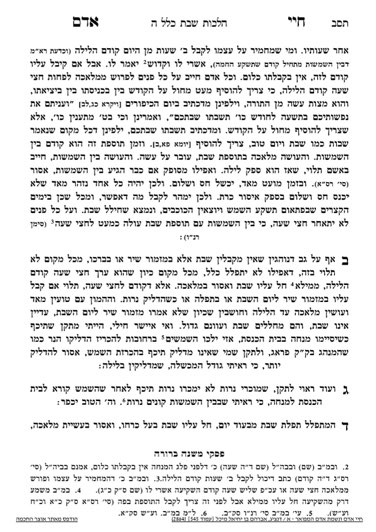We are continuing in siman 1. The Chayei Adam writes that there is a mitzvah of tosefes Shabbos both on erev Shabbos and motzei Shabbos.
The Chayei Adam follows the majority opinion of the rishonim that tosefes Shabbos is deoraysa. He writes that the source is the pasuk regarding Yom Kippur which states be’tisha lachodesh ba’erev, mei’erev ad erev, seemingly implying that Yom Kippur begins on the 9th of Tishrei. The Gemara learns from here that we attach some of the 9th to Yom Kippur, as we have learned (S0110). The Gemara continues, and says that since the pasuk ends with the words tishbesu shabatchem (to rest on your sabbath), we learn that in any place that the Torah tells us to rest, we must add from the previous day as well. Thus, we learn from Yom Kippur that there is a mitzvah deoraysa of tosfes Shabbos by all Shabbosim and Yomim Tovim.
The Chayei Adam continues, and writes that the correct time to add tosefes Shabbos is before bein hashmashos. During bein hashmashos one must certainly refrain from melacha, because it is a safeik deoraysa. If a person does melacha during the time of tosefes shabbos, they are not chayav kareis or any other punishment, as it is a mitzvas asei to refrain from melacha during that time, but there is no punishment for not fulfilling a mitzvas asei. On the other hand, bein hashmashos is a safeik chiyuv kareis, so one who performs melacha during that time would be chayav a korban asham talui.
The Chayei Adam adds that not only is bein hashmashos assur, but it is assur to perform melacha when there is a safeik bein hashmashos as well. As we have learned (S0040), one should not perform melacha down to the last minute, because atmospheric variables can change when sunset actually occurs. The possible imprecision of one’s clock should be taken into account as well.
Thus, for example, if the calendar says sunset is 7:13:15, it can be imprecise due to atmospheric variables, imprecision of one’s clock, and the imprecision of the exact place for which the calendar is reporting. The recommendation is to be machmir by two minutes. Tosefes Shabbos would begin before those two minutes.
It goes without saying that it is appropriate to accept Shabbos as early as one is able to, in order to avoid these concerns. It is certainly true in the winter, where the shorter days cause nightfall to come quicker. Nevertheless, the minimum amount recommended by the Chayei Adam is 30 minutes, as we have learned (S0111).
Summary
- Tosefes Shabbos is a mitzvas asei; if one does melacha during that time there is no punishment.
- Bein hashmashos is a safeik deoraysa, and there is a chiyuv asham talui for performing melacha during that time.
- Minimally, the Chayei Adam holds one should accept Shabbos 30 minutes before nightfall. This includes enough time for bein hashmashos, two minutes to avoid a safeik bein hashmashos, and a few minutes for tosefes Shabbos.
- Bein hashmashos does not count towards the mitzvah of tosefes Shabbos.



